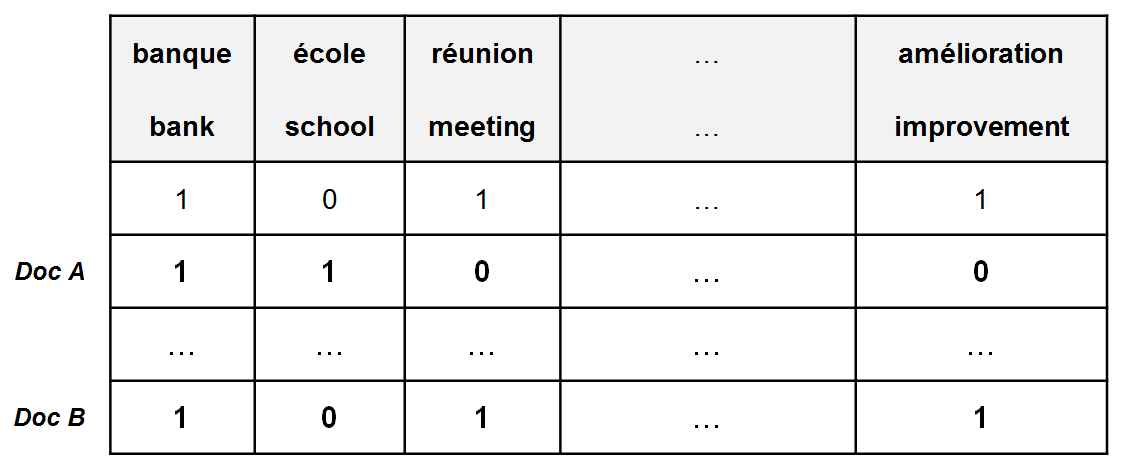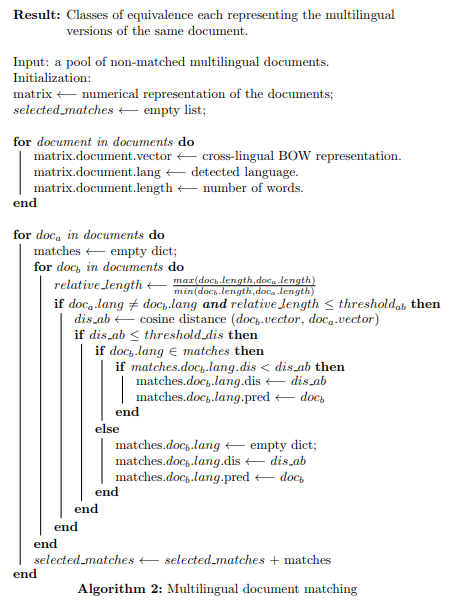Building Parallel Corpora Using Cross-Lingual BOW
Training machine translation models requires a huge amount of parallel data. Consequently, there has been many works suggesting different methods to build bilingual corpora, leading to the construction of reliable training datasets for machine translation systems.
However, the problem is still prominent for the below use-cases:
- Low-resource setup: Although for some language pairs, we have parallel datasets with a convenient size (e.g. around 50M sentences for French - English), this is not the case for all language pairs. Indeed, low resource languages do not have as much parallel data making it hard to train reliable translation models to and from these languages.
- Specialization setup: Furthermore, machine translation is sensitive to context. Thus, any available specialized data can have a strong influence on the model’s performance for a specific domain. For instance, using medical data when training the model enhances its performance on prescriptions’ translation. Note that there are various domain control strategies for machine translation, such as adding the domain tag as an additional feature or adding a special token to the sentence when training and translating; this is not, however, the core of this article.
Due to the aforementioned reasons, there is still room for designing and implementing solutions for building parallel corpora. In the following sections, I present a solution for matching multilingual documents in order to construct a parallel corpus.
CLBOW: Cross-Lingual Bag-Of-Words
When designing an algorithm to match cross-lingual documents, the first reflex is to represent all available documents in numerical vectors. However, to compare these documents, the vectorial representations should be language-independent or cross-lingual, meaning that semantically similar documents should be close in the multidimensional representation space.
Although most recent research works focus on multilingual word embeddings as a numerical representation of text data, here we present a generalization of Bag-Of-Words to a cross-lingual setup, where we represent all documents in the same space irrespectively of their language. Below is the explicit implementation of the algorithm:

Illustration of Cross-Lingual Bag-Of-Words (CLBOW):

Notes:
- In the above illustration, the decoding of only two languages is presented for simplicity purposes; nevertheless the suggested implementation is extended to many languages.
- Furthermore, it can handle polysemy since at each decoding step t, not only one translation of the word wt is considered but its different translations.
- This version of BOW can provide both binary and numerical representation of the documents. By numerical, I refer to the extension of TF-IDF (Term Frequency - Inverse Document Frequency) to a cross-lingual setup.
Application to parallel corpora construction
Thanks to the previous algorithm, cross-lingual vectorial representations of the documents are calculated. Afterwards, a search for the closest document of a different language is performed using the minimization of the cosine distance and with regards to a threshold corresponding to the typical length ratio for the language pair. For instance, this threshold is equal to 1.5 for French-English bilingual corpora. A maximum accepted distance between a document and a candidate translated version is also considered, to discriminate documents having the same template (headers, footers, etc.). In my various experiments, this threshold is equal to 0.6.
Using this method, classes of equivalence representing each the multilingual versions of the same document are retrieved. For example, a class of equivalence can be represented as the following:
{'fr': 'Regle FR 29-01-2018.pdf',
'en': 'CS1548325.pdf',
'pt' : 'Regra 29-01-2018.pdf'
}
{'fr': 'Doc 12052005.pdf',
'en': 'To print.pdf',
'de' : 'pr12052005.pdf'
}
Below is the detailed algorithm:

To build bilingual corpora, I consider sequentially pairs of languages. Then on each pair of documents, I apply sentence alignment using the algorithm BLEUAlign. This will provide a bilingual parallel corpus for each data source relevant to a specific domain. These corpora are then used to train and specialize machine translation systems and using them enabled a good enhancement in BLEU score. Generally, if ∆BLEU is the difference between the BLEU on a standard dataset and a specialized dataset of the general model, you should expect to gain around ∆BLEU on the specialized dataset using the augmented model.
Conclusion
The here-presented pipeline enabled the construction of a specialized bilingual corpus, that I used to enhance the performance of translation models both on standard datasets and on specialized data (financial, medical, etc.). Other improvements are however to be tested in the near future, including neural encoding of multilingual documents.